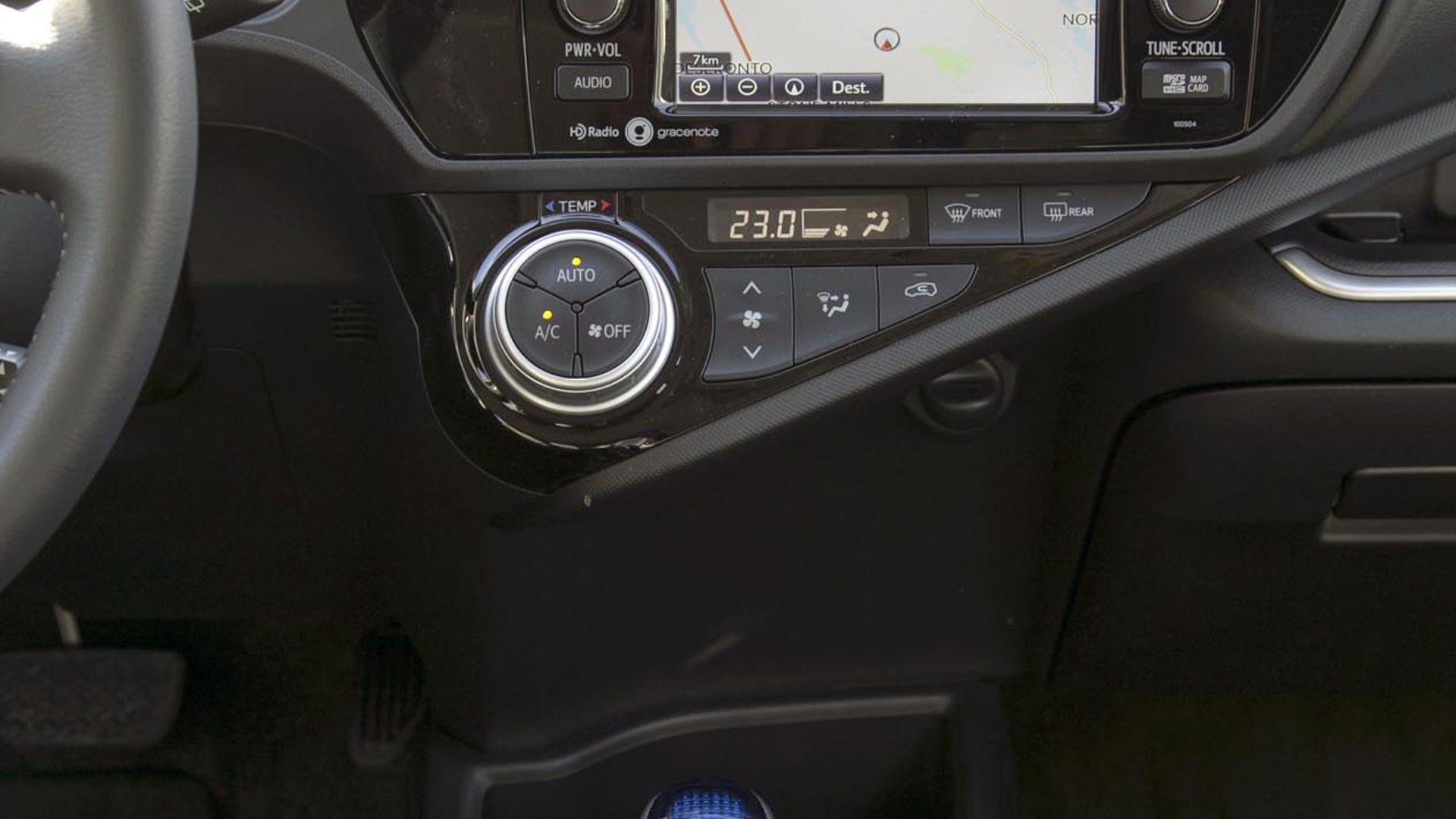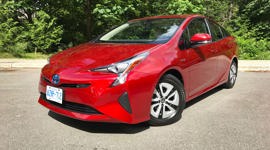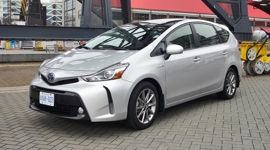 AutoTrader SCORE
AutoTrader SCORE
-
EXTERIOR STYLING7/10
-
INTERIOR5/10
-
PERFORMANCE4/10
-
COMFORT6/10
-
FUEL ECONOMY10/10
Let’s begin with three great aspects of the 2015 Toyota Prius c.
“I know you’d rather take your bicycle but sometimes you just need a car, so good for you for selecting a Prius.”
First off, as one would expect, it is very fuel-efficient.
Next, its compact dimensions mean it’s highly maneuverable in tight urban spaces. Navigating narrow alleyways or squeezing into “Small Car Only” spots in the underground is a snap with the subcompact Toyota.
Third, the “Tangerine Splash Pearl” paint of this test car contains more vitamin C than a carton of Tropicana.
Okay, that last part is clearly a fabrication, but as the week went by, I found the hue of this car dominated most of the conversations around it.
“Hey, who’s driving that orange thing?” and “Wow, that sure is a bright colour!” most commonly preceded, “What car is that anyway?”
While the Prius c’s larger sibling (known just as Prius) has a more distinctive Priusness to its visage, it would seem most casual observers think someone driving Toyota Canada’s smallest hybrid painted orange are simply attention-seeking frugal shoppers.
That paint also earned this Prius c a number of names too. A weekend visit to my parents’ place across the province had my mom calling it a little pumpkin on wheels. My five-year-old son thought it looked like a Pokémon. But I think it’s best if we call it Clementine. It’s cute and sweet and good for you, and the burgers, cigarettes and Budweiser crowd just don’t get the appeal of it.
But to the crowd who buys certifiably organic and sustainable Arabica beans from the fancy roaster place in their major urban centre, this most affordable hybrid is a desirable choice. To these hip or hipster young, urban Canadians, the Prius c shows both fiscal and environmental responsibility to their most judgmental peers.
“I know you’d rather take your bicycle but sometimes you just need a car, so good for you for selecting a Prius.”
It’s like choosing to adopt a blind rescue dog and wear recycled burlap pants made by homeless war refugees. Who could criticize such socially upstanding behavior? And certainly if you plan to drive primarily in a congested urban centre, the Prius c (the “c” standing for “city”) really is a noble choice.
Thanks to Toyota’s well-proven Hybrid Synergy Drive system, here with a 1.5L inline four-cylinder Atkinson cycle, Clementine happily putters around in dense traffic, doing its thing. That thing could be getting you to and from the St. Lawrence Market on a Saturday afternoon, dodging pedestrians, bikes and Blue Jays fans, propelled by the engine, the 144 volt nickel-metal hydride battery-powered motor or a combination thereof. You’ll impress no one, but neither will you be called an ostentatious show-off either. Plus, that orange paint makes you as visible as traffic pylon, helping the cell-phone-distracted drivers to avoid running into you.
At slow speed, the EV mode allows the Prius c to deplete only battery juice, and in Eco mode, I found the car eager to avoid sipping fuel whenever possible at the expense of what precious little throttle response one might find in Normal mode.
The Prius c is rated at 4.5 L/100 km in the city which is about as good as you can get without going to a plug-in or full-on EV car like Nissan’s LEAF that starts several thousand dollars higher than the Prius c before you.
But what if you are among the millions who live in the vast expanses of Canadian suburbia (or better still, you’re among the hearty souls in rural Canada), does Clementine still make sense when the distances are greater and so are the velocities?
If your primary goal in life is to use as little fuel as possible, then possibly yes. During an 800 km road trip that featured mostly highway driving (much of it at speeds above the posted limit), the Prius c delivered an observed consumption average of 5.3 L/100 km. This is higher than Toyota’s estimate of 5.1L, but given the speed and the fact that the press car was rolling on less efficient winter rubber, it’s a pretty awesome achievement.
Be that as it may, Clementine never seems to enjoy itself when out for a run at highway speeds. The CVT transmission forces the little engine to moan and shout coarsely every time an extra km/h or two is requested. What’s more, you’ve not experienced true terror until you’ve tried to pass slightly slower moving traffic on a narrow two-lane highway in a Prius c. That speck on the horizon when you initiated the pass quickly looms large in your face as you’re urging Clementine to eke out every last one of those 99 (combined) horsepower before darting in front of Ethel and Ernie on their Sunday country drive.
There are a number of really good subcompact cars on the market today that can achieve nearly the same highway efficiency as the Prius c, most of which are far more engaging to drive. Clementine’s fuel tank space is largely absorbed by batteries, leaving only 36L of volume for go-juice. This still gives a range of 650-700 km per tank, but that’s far less than you’d get in a Volkswagen Golf TDI.
With fuel costs what they are today, it could still take upwards of four or more years for the average driver to cover the additional cost of buying this Prius c over a comparably equipped Toyota Yaris SE. The Yaris is a car of nearly equal proportions inside and out and one that should provide owners with the same expectation for years of trouble-free motoring. While we complained about some of the Yaris’s road manners in a recent comparison test, it (along with many of its contemporaries from other companies) is still more enjoyable and spritely to drive than the Prius c.
“Who cares?” a likely Prius c buyer will ask. After all, driving is about necessity, not enjoyment, right? Maybe so.
But there are other complaints to be levied against Clementine. This Prius c tester is loaded up with the Technology package that includes a navigation system displayed on a 6.1-inch touchscreen, and features a back-up camera and email-to-speech capability. The system works well enough, but the screen is small, dull and low-res by modern standards. Still, its ease of use and the stereo’s decent sound quality make it a worthwhile component.
The seats – covered in the softest, most luxurious vinyl you’ve ever felt – fill the cabin with an overwhelming aroma of man-made materials, especially when the car has been sitting in the sun for a while heating up all those synthetics. The seats also lack sufficient lumbar support, causing some added fatigue on long stints behind the wheel.
Curiously, Toyota’s interior designers place the primary gauges in all Prius models slightly left of centre atop the dash, rather than directly in front of the driver as in all their other products. Do Prius buyers all have eyes slightly askew on their faces? If there’s an appreciable benefit to this system, it’s lost on me, and given that they don’t apply this technique to other models, I suppose it’s just keeping the Priuses different for the sake of being different.
In Clementine, the primary display is squeezed to the left side of the broad display panel, and features speed, gear indicator and fuel level. Beside it is a graphic box that cycles through trip information, vehicle information, fuel costs and an efficiency score. I saw my score fluctuate between 39/100 and 79/100. The remaining real estate on the display is dedicated to a handful of warning lights.
Lastly, the heated seat buttons are situated low down and obscured by the parking brake lever, plus there is no auto headlight feature despite this being a Technology Package car. It should be noted; the new LED headlights are fantastic.
With $255 in optional premium paint, Clementine rings the register at $28,000 after freight and PDI. It’s a well-equipped car offering some cool features and fantastic efficiency that’s still thousands less than a comparably equipped LEAF, Chevrolet Volt or even Prius lift back. With styling reminiscent of most of the current crop of cheaper and more enjoyable subcompact cars for sale today Prius c owners will need to point out the hybrid badge for their social pat on the back.
If you’re an urban dweller in a congested city, the Prius c could be a good choice for you, but if you’re outside the urban core, saving a few grand on the purchase price will go a long way toward making up for the fuel savings.
| Warranty: 3 years/60,000 km; 5 years/100,000 km powertrain; 5 years/unlimited distance corrosion perforation; 3 years/60,000 km 24-hour roadside assistance; 8 years/160,000 km hybrid-related components Competitors: |
| Model Tested | 2015 Toyota Prius c Technology |
|---|---|
| Base Price | $26,055 |
| A/C Tax | $100 |
| Destination Fee | $1,620 |
| Price as Tested | $28,030 |
|
Optional Equipment
Optional Colour Premium Paint, $255
|
|






























